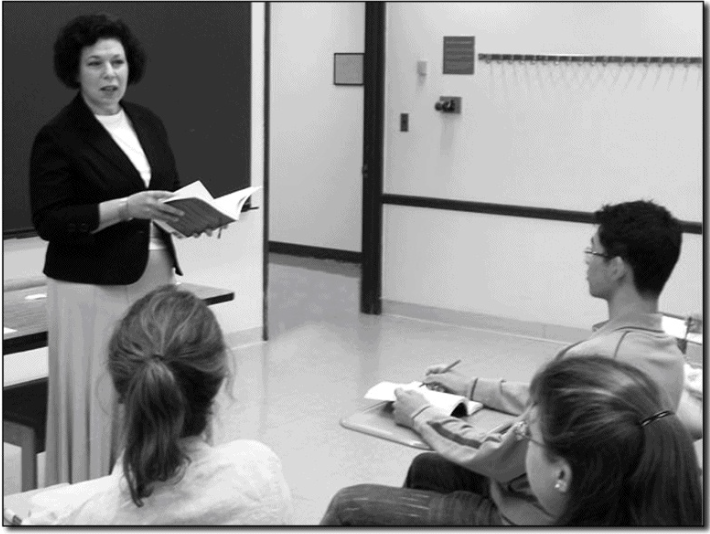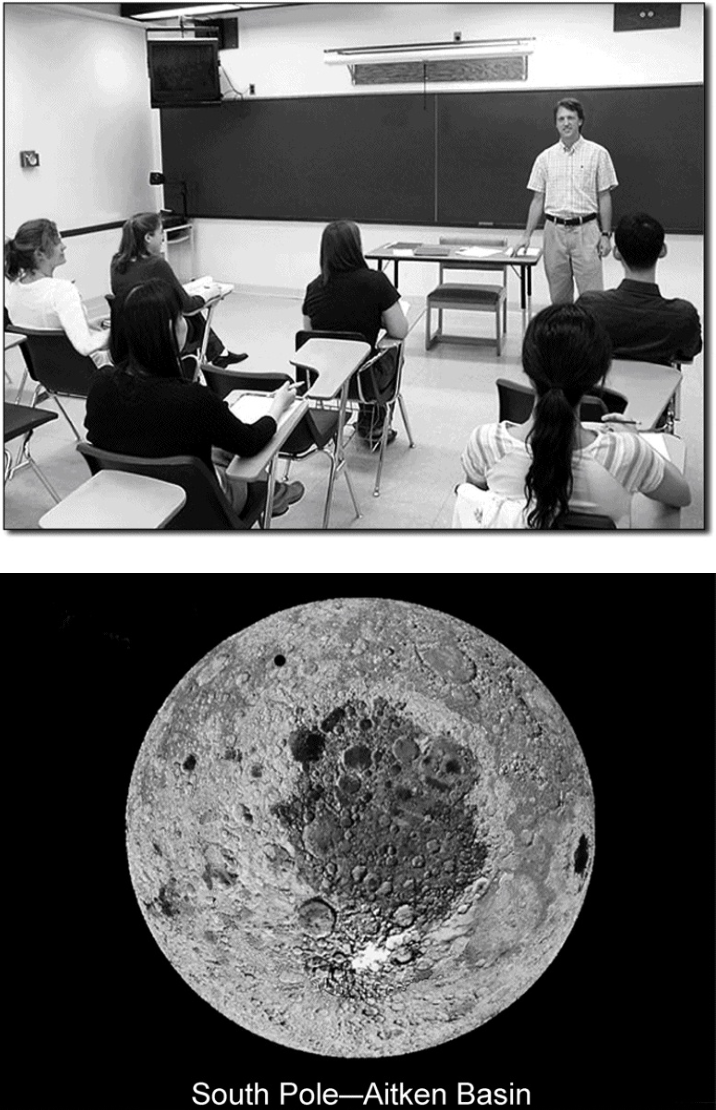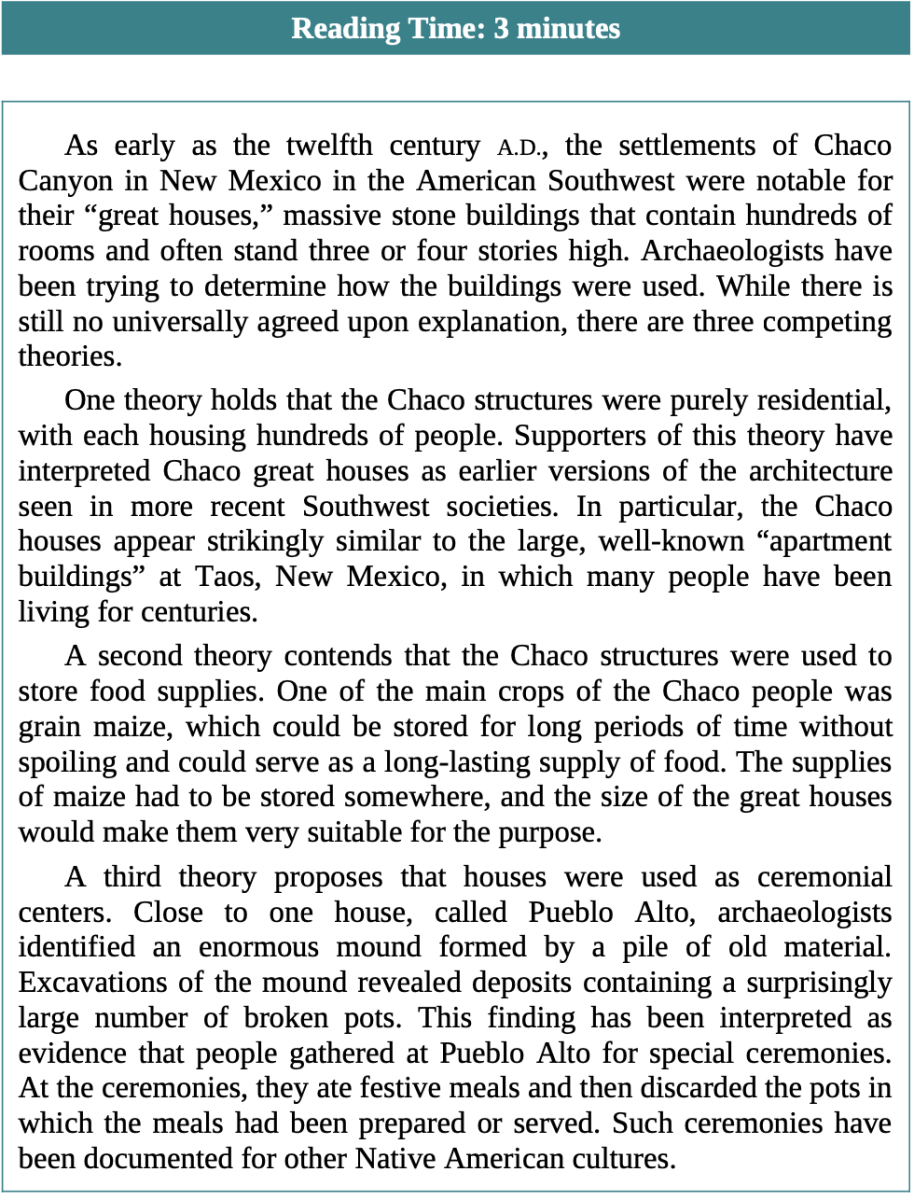OFFICIAL iBT Test (Volume 1) - Test 2
READING
This section measures your ability to understand academic passages in English.
There are three passages in the section. Give yourself 18 minutes to read each passage and answer the questions about it. The entire section will take 54 minutes to complete.
You may look back at a passage when answering the questions. You can skip questions and go back to them later as long as there is time remaining.
Directions: Read the passage. Then answer the questions. Give yourself 18 minutes to complete this practice set.
MINERALS AND PLANTS
Research has shown that certain minerals are required by plants for normal growth and development. The soil is the source of these minerals, which are absorbed by the plant with the water from the soil. Even nitrogen, which is a gas in its elemental state, is normally absorbed from the soil as nitrate ions. Some soils are notoriously deficient in micro nutrients and are therefore unable to support most plant life. So-called serpentine soils, for example, are deficient in calcium, and only plants able to tolerate low levels of this mineral can survive. In modern agriculture, mineral depletion of soils is a major concern, since harvesting crops interrupts the recycling of nutrients back to the soil.
Mineral deficiencies can often be detected by specific symptoms such as chlorosis (loss of chlorophyll resulting in yellow or white leaf tissue), necrosis (isolated dead patches), anthocyanin formation (development of deep red pigmentation of leaves or stem), stunted growth, and development of woody tissue in an herbaceous plant. Soils are most commonly deficient in nitrogen and phosphorus. Nitrogen-deficient plants exhibit many of the symptoms just described. Leaves develop chlorosis; stems are short and slender; and anthocyanin discoloration occurs on stems, petioles, and lower leaf surfaces. Phosphorus-deficient plants are often stunted, with leaves turning a characteristic dark green, often with the accumulation of anthocyanin. Typically, older leaves are affected first as the phosphorus is mobilized to young growing tissue. Iron deficiency is characterized by chlorosis between veins in young leaves.
Much of the research on nutrient deficiencies is based on growing plants hydroponically, that is, in soilless liquid nutrient solutions. This technique allows researchers to create solutions that selectively omit certain nutrients and then observe the resulting effects on the plants. Hydroponics has applications beyond basic research, since it facilitates the growing of greenhouse vegetables during winter. Aeroponics, a technique in which plants are suspended and the roots misted with a nutrient solution, is another method for growing plants without soil.
While mineral deficiencies can limit the growth of plants, an overabundance of certain minerals can be toxic and can also limit growth. Saline soils, which have high concentrations of sodium chloride and other salts, limit plant growth, and research continues to focus on developing salt- tolerant varieties of agricultural crops. Research has focused on the toxic effects of heavy metals such as lead, cadmium, mercury, and aluminum; however, even copper and zinc, which are essential elements, can become toxic in high concentrations. Although most plants cannot survive in these soils, certain plants have the ability to tolerate high levels of these minerals.
Scientists have known for some time that certain plants, called hyperaccumulators, can concentrate minerals at levels a hundredfold or greater than normal. A survey of known hyperaccumulators identified that 75 percent of them amassed nickel; cobalt, copper, zinc, manganese, lead, and cadmium are other minerals of choice. Hyperaccumulators run the entire range of the plant world. They may be herbs, shrubs, or trees. Many members of the mustard family, spurge family, legume family, and grass family are top hyperaccumulators. Many are found in tropical and subtropical areas of the world, where accumulation of high concentrations of metals may afford some protection against plant-eating insects and microbial pathogens.
Only recently have investigators considered using these plants to clean up soil and waste sites that have been contaminated by toxic levels of heavy metals—an environmentally friendly approach known as phytoremediation. This scenario begins with the planting of hyperaccumulating species in the target area, such as an abandoned mine or an irrigation pond contaminated by runoff. Toxic minerals would first be absorbed by roots but later relocated to the stem and leaves. A harvest of the shoots would remove the toxic compounds off site to be burned or composted to recover the metal for industrial uses. After several years of cultivation and harvest, the site would be restored at a cost much lower than the price of excavation and reburial, the standard practice for remediation of contaminated soils. For example, in field trials, the plant alpine pennycress removed zinc and cadmium from soils near a zinc smelter, and Indian mustard, native to Pakistan and India, has been effective in reducing levels of selenium salts by 50 percent in contaminated soils.
Directions: Now answer the questions.
PARAGRAPH 1
Research has shown that certain minerals are required by plants for normal growth and development. The soil is the source of these minerals, which are absorbed by the plant with the water from the soil. Even nitrogen, which is a gas in its elemental state, is normally absorbed from the soil as nitrate ions. Some soils are notoriously deficient in micro nutrients and are therefore unable to support most plant life. So-called serpentine soils, for example, are deficient in calcium, and only plants able to tolerate low levels of this mineral can survive. In modern agriculture, mineral depletion of soils is a major concern, since harvesting crops interrupts the recycling of nutrients back to the soil.
1. According to paragraph 1, what is true of plants that can grow in serpentine soils?
A. They absorb micronutrients unusually well.
B. They require far less calcium than most plants do.
C. They are able to absorb nitrogen in its elemental state.
D. They are typically crops raised for food.
PARAGRAPH 2
Mineral deficiencies can often be detected by specific symptoms such as chlorosis (loss of chlorophyll resulting in yellow or white leaf tissue), necrosis (isolated dead patches), anthocyanin formation (development of deep red pigmentation of leaves or stem), stunted growth, and development of woody tissue in an herbaceous plant. Soils are most commonly deficient in nitrogen and phosphorus. Nitrogen-deficient plants exhibit many of the symptoms just described. Leaves develop chlorosis; stems are short and slender; and anthocyanin discoloration occurs on stems, petioles, and lower leaf surfaces. Phosphorus-deficient plants are often stunted, with leaves turning a characteristic dark green, often with the accumulation of anthocyanin. Typically, older leaves are affected first as the phosphorus is mobilized to young growing tissue. Iron deficiency is characterized by chlorosis between veins in young leaves.
2. According to paragraph 2, which of the following symptoms occurs in phosphorus-deficient plants but not in plants deficient in nitrogen or iron?
A. Chlorosis on leaves
B. Change in leaf pigmentation to a dark shade of green
C. Short, stunted appearance of stems
D. Reddish pigmentation on the leaves or stem
3. According to paragraph 2, a symptom of iron deficiency is the presence in young leaves of
A. deep red discoloration between the veins
B. white or yellow tissue between the veins
C. dead spots between the veins
D. characteristic dark green veins
PARAGRAPH 3
Much of the research on nutrient deficiencies is based on growing plants hydroponically, that is, in soilless liquid nutrient solutions. This technique allows researchers to create solutions that selectively omit certain nutrients and then observe the resulting effects on the plants. Hydroponics has applications beyond basic research, since it facilitates the growing of greenhouse vegetables during winter. Aeroponics, a technique in which plants are suspended and the roots misted with a nutrient solution, is another method for growing plants without soil.
4. The word “facilitates” in the passage is closest in meaning to
A. slows down
B. affects
C. makes easier
D. focuses on
5. According to paragraph 3, what is the advantage of hydroponics for research on nutrient deficiencies in plants?
A. It allows researchers to control what nutrients a plant receives.
B. It allows researchers to observe the growth of a large number of plants simultaneously.
C. It is possible to directly observe the roots of plants.
D. It is unnecessary to keep misting plants with nutrient solutions.
PARAGRAPH 5
Scientists have known for some time that certain plants, called hyperaccumulators, can concentrate minerals at levels a hundredfold or greater than normal. A survey of known hyperaccumulators identified that 75 percent of them amassed nickel; cobalt, copper, zinc, manganese, lead, and cadmium are other minerals of choice. Hyperaccumulators run the entire range of the plant world. They may be herbs, shrubs, or trees. Many members of the mustard family, spurge family, legume family, and grass family are top hyperaccumulators. Many are found in tropical and subtropical areas of the world, where accumulation of high concentrations of metals may afford some protection against plant-eating insects and microbial pathogens.
6. Why does the author mention “herbs,” “shrubs,” and “trees”?
A. To provide examples of plant types that cannot tolerate high levels of harmful minerals
B. To show why so many plants are hyperaccumulators
C. To help explain why hyperaccumulators can be found in so many different places
D. To emphasize that hyperaccumulators occur in a wide range of plant types
PARAGRAPH 6
Only recently have investigators considered using these plants to clean up soil and waste sites that have been contaminated by toxic levels of heavy metals—an environmentally friendly approach known as phytoremediation. This scenario begins with the planting of hyperaccumulating species in the target area, such as an abandoned mine or an irrigation pond contaminated by runoff. Toxic minerals would first be absorbed by roots but later relocated to the stem and leaves. A harvest of the shoots would remove the toxic compounds off site to be burned or composted to recover the metal for industrial uses. After several years of cultivation and harvest, the site would be restored at a cost much lower than the price of excavation and reburial, the standard practice for remediation of contaminated soils. For example, in field trials, the plant alpine pennycress removed zinc and cadmium from soils near a zinc smelter, and Indian mustard, native to Pakistan and India, has been effective in reducing levels of selenium salts by 50 percent in contaminated soils.
7. Which of the sentences below best expresses the essential information in the highlighted sentence in paragraph 6? Incorrect choices change the meaning in important ways or leave out essential information.
A. Before considering phytoremediation, hyperaccumulating species of plants local to the target area must be identified.
B. The investigation begins with an evaluation of toxic sites in the target area to determine the extent of contamination.
C. The first step in phytoremediation is the planting of hyperaccumulating plants in the area to be cleaned up.
D. Mines and irrigation ponds can be kept from becoming contaminated by planting hyperaccumulating species in targeted areas.
8. It can be inferred from paragraph 6 that compared with standard practices for remediation of contaminated soils, phytoremediation
A. does not allow for the use of the removed minerals for industrial purposes
B. can be faster to implement
C. is equally friendly to the environment
D. is less suitable for soils that need to be used within a short period of time
PARAGRAPH 5
Scientists have known for some time that certain plants, called hyperaccumulators, can concentrate minerals at levels a hundredfold or greater than normal. (A) A survey of known hyperaccumulators identified that 75 percent of them amassed nickel; cobalt, copper, zinc, manganese, lead, and cadmium are other minerals of choice. (B) Hyperaccumulators run the entire range of the plant world. (C) They may be herbs, shrubs, or trees. (D) Many members of the mustard family, spurge family, legume family, and grass family are top hyperaccumulators. Many are found in tropical and subtropical areas of the world, where accumulation of high concentrations of metals may afford some protection against plant-eating insects and microbial pathogens.
9. Look at the part of the passage that is displayed above. The letters (A), (B), (C), and (D) indicate where the following sentence could be added.
Certain minerals are more likely to be accumulated in large quantities than others.
Where would the sentence best fit?
A. Choice A
B. Choice B
C. Choice C
D. Choice D
10. Directions: An introductory sentence for a brief summary of the passage is provided below. Complete the summary by selecting the THREE answer choices that express the most important ideas in the passage. Some sentences do not belong in the summary because they express ideas that are not presented in the passage or are minor ideas in the passage.
Write your answer choices in the spaces where they belong. You can either write the letter of your answer choice or you can copy the sentence.
Answer Choices
A. Some plants can tolerate comparatively low levels of certain minerals, but such plants are of little use for recycling nutrients back into depleted soils.
B. When plants do not absorb sufficient amounts of essential minerals, characteristic abnormalities result.
C. Mineral deficiencies in many plants can be cured by misting their roots with a nutrient solution or by transferring the plants to a soilless nutrient solution.
D. Though beneficial in lower levels, high levels of salts, other minerals, and heavy metals can be harmful to plants.
E. Because high concentrations of sodium chloride and other salts limit growth in most plants, much research has been done in an effort to develop salt-tolerant agricultural crops.
F. Some plants are able to accumulate extremely high levels of certain minerals and thus can be used to clean up soils contaminated with toxic levels of these minerals.
Directions: Read the passage. Then answer the questions. Give yourself 18 minutes to complete this practice set.
THE ORIGIN OF THE PACIFIC ISLAND PEOPLE
The greater Pacific region, traditionally called Oceania, consists of three cultural areas: Melanesia, Micronesia, and Polynesia. Melanesia, in the southwest Pacific, contains the large islands of New Guinea, the Solomons, Vanuatu, and New Caledonia. Micronesia, the area north of Melanesia, consists primarily of small scattered islands. Polynesia is the central Pacific area in the great triangle defined by Hawaii, Easter Island, and New Zealand. Before the arrival of Europeans, the islands in the two largest cultural areas, Polynesia and Micronesia, together contained a population estimated at 700,000.
Speculation on the origin of these Pacific islanders began as soon as outsiders encountered them; in the absence of solid linguistic, archaeological, and biological data, many fanciful and mutually exclusive theories were devised. Pacific islanders were variously thought to have come from North America, South America, Egypt, Israel, and India, as well as Southeast Asia. Many older theories implicitly deprecated the navigational abilities and overall cultural creativity of the Pacific islanders. For example, British anthropologists G. Elliot Smith and W. J. Perry assumed that only Egyptians would have been skilled enough to navigate and colonize the Pacific. They speculated that the Egyptians even crossed the Pacific to found the great civilizations of the New World (North and South America). In 1947 Norwegian adventurer Thor Heyerdahl drifted on a balsa-log raft westward with the winds and currents across the Pacific from South America to prove his theory that Pacific islanders were Native Americans (also called American Indians). Later Heyerdahl suggested that the Pacific was peopled by three migrations: by Native Americans from the Pacific Northwest of North America drifting to Hawaii, by Peruvians drifting to Easter Island, and by Melanesians. In 1969 he crossed the Atlantic in an Egyptian-style reed boat to prove Egyptian influences in the Americas. Contrary to these theorists, the overwhelming evidence of physical anthropology, linguistics, and archaeology shows that the Pacific islanders came from Southeast Asia and were skilled enough as navigators to sail against the prevailing winds and currents.
The basic cultural requirements for the successful colonization of the Pacific islands include the appropriate boat-building, sailing, and navigation skills to get to the islands in the first place; domesticated plants and gardening skills suited to often marginal conditions; and a varied inventory of fishing implements and techniques. It is now generally believed that these prerequisites originated with peoples speaking Austronesian languages (a group of several hundred related languages) and began to emerge in Southeast Asia by about 5000 B.C.E. The culture of that time, based on archaeology and linguistic reconstruction, is assumed to have had a broad inventory of cultivated plants including taro, yams, banana, sugarcane, breadfruit, coconut, sago, and rice. Just as important, the culture also possessed the basic foundation for an effective maritime adaptation, including outrigger canoes and a variety of fishing techniques that could be effective for overseas voyaging.
Contrary to the arguments of some that much of the Pacific was settled by Polynesians accidentally marooned after being lost and adrift, it seems reasonable that this feat was accomplished by deliberate colonization expeditions that set out fully stocked with food and domesticated plants and animals. Detailed studies of the winds and currents using computer simulations suggest that drifting canoes would have been a most unlikely means of colonizing the Pacific. These expeditions were likely driven by population growth and political dynamics on the home islands, as well as the challenge and excitement of exploring unknown waters. Because all Polynesians, Micronesians, and many Melanesians speak Austronesian languages and grow crops derived from Southeast Asia, all these peoples most certainly derived from that region and not the New World or elsewhere. The undisputed pre-Columbian presence in Oceania of the sweet potato, which is a New World domesticate, has sometimes been used to support Heyerdahl’s “American Indians in the Pacific” theories. However, this is one plant out of a long list of Southeast Asian domesticates. As Patrick Kirch, an American anthropologist, points out, rather than being brought by rafting South Americans, sweet potatoes might just have easily been brought back by returning Polynesian navigators who could have reached the west coast of South America.
Directions: Now answer the questions.
PARAGRAPH 1
Speculation on the origin of these Pacific islanders began as soon as outsiders encountered them; in the absence of solid linguistic, archaeological, and biological data, many fanciful and mutually exclusive theories were devised. Pacific islanders were variously thought to have come from North America, South America, Egypt, Israel, and India, as well as Southeast Asia. Many older theories implicitly deprecated the navigational abilities and overall cultural creativity of the Pacific islanders. For example, British anthropologists G. Elliot Smith and W. J. Perry assumed that only Egyptians would have been skilled enough to navigate and colonize the Pacific. They inferred that the Egyptians even crossed the Pacific to found the great civilizations of the New World (North and South America). In 1947 Norwegian adventurer Thor Heyerdahl drifted on a balsa-log raft westward with the winds and currents across the Pacific from South America to prove his theory that Pacific islanders were Native Americans (also called American Indians). Later Heyerdahl suggested that the Pacific was peopled by three migrations: by Native Americans from the Pacific Northwest of North America drifting to Hawaii, by Peruvians drifting to Easter Island, and by Melanesians. In 1969 he crossed the Atlantic in an Egyptian-style reed boat to prove Egyptian influences in the Americas. Contrary to these theorists, the overwhelming evidence of physical anthropology, linguistics, and archaeology shows that the Pacific islanders came from Southeast Asia and were skilled enough as navigators to sail against the prevailing winds and currents.
11. By stating that the theories are “mutually exclusive” the author means that
A. if one of the theories is true, then all the others must be false
B. the differences between the theories are unimportant
C. taken together, the theories cover all possibilities
D. the theories support each other
12. According to paragraph 2, which of the following led some early researchers to believe that the Pacific islanders originally came from Egypt?
A. Egyptians were known to have founded other great civilizations.
B. Sailors from other parts of the world were believed to lack the skills needed to travel across the ocean.
C. Linguistic, archaeological, and biological data connected the islands to Egypt.
D. Egyptian accounts claimed responsibility for colonizing the Pacific as well as the Americas.
PARAGRAPH 3
The basic cultural requirements for the successful colonization of the Pacific islands include the appropriate boat-building, sailing, and navigation skills to get to the islands in the first place; domesticated plants and gardening skills suited to often marginal conditions; and a varied inventory of fishing implements and techniques. It is now generally believed that these prerequisites originated with peoples speaking Austronesian languages (a group of several hundred related languages) and began to emerge in Southeast Asia by about 5000 B.C.E. The culture of that time, based on archaeology and linguistic reconstruction, is assumed to have had a broad inventory of cultivated plants including taro, yams, banana, sugarcane, breadfruit, coconut, sago, and rice. Just as important, the culture also possessed the basic foundation for an effective maritime adaptation, including outrigger canoes and a variety of fishing techniques that could be effective for overseas voyaging.
13. The word “implements” in the passage is closest in meaning to.
A. skills
B. tools
C. opportunities.
D. practices
14. All of the following are mentioned in paragraph 3 as required for successful colonization of the Pacific islands EXCEPT
A. knowledge of various Austronesian languages
B. a variety of fishing techniques
C. navigational skills
D. knowledge of plant cultivation
15. In paragraph 3, why does the author provide in formation about the types of crops grown and boats used in Southeast Asia during the period around 5000 B.C.E.?
A. To evaluate the relative importance of agriculture and fishing to early Austronesian peoples
B. To illustrate the effectiveness of archaeological and linguistic methods in discovering details about life in ancient times
C. To contrast living conditions on the continent of Asia with living conditions on the Pacific islands
D. To demonstrate that people from this region had the skills and resources necessary to travel to and survive on the Pacific islands
PARAGRAPH 4
Contrary to the arguments of some that much of the Pacific was settled by Polynesians accidentally marooned after being lost and adrift, it seems reasonable that this feat was accomplished by deliberate colonization expeditions that set out fully stocked with food and domesticated plants and animals. Detailed studies of the winds and currents using computer simulations suggest that drifting canoes would have been a most unlikely means of colonizing the Pacific. These expeditions were likely driven by population growth and political dynamics on the home islands, as well as the challenge and excitement of exploring unknown waters. Because all Polynesians, Micronesians, and many Melanesians speak Austronesian languages and grow crops derived from Southeast Asia, all these peoples most certainly derived from that region and not the New World or elsewhere. The undisputed pre-Columbian presence in Oceania of the sweet potato, which is a New World domesticate, has sometimes been used to support Heyerdahl’s “American Indians in the Pacific” theories. However, this is one plant out of a long list of Southeast Asian domesticates. As Patrick Kirch, an American anthropologist, points out, rather than being brought by rafting South Americans, sweet potatoes might just have easily been brought back by returning Polynesian navigators who could have reached the west coast of South America.
16. Which of the sentences below best expresses the essential information in the highlighted sentence in paragraph 4? Incorrect choices change the meaning in important ways or leave out essential information.
A. Some people have argued that the Pacific was settled by traders who became lost while transporting domesticated plants and animals.
B. The original Polynesian settlers were probably marooned on the islands, but they may have been joined later by carefully prepared colonization expeditions.
C. Although it seems reasonable to believe that colonization expeditions would set out fully stocked, this is contradicted by much of the evidence.
D. The settlement of the Pacific islands was probably intentional and well planned rather than accidental as some people have proposed.
17. According to paragraph 4, which of the following is NOT an explanation for why a group of people might have wanted to colonize the Pacific islands?
A. As their numbers increased, they needed additional territory.
B. The winds and currents made the islands easy to reach.
C. The political situation at home made emigration desirable.
D. They found exploration challenging and exciting.
18. Why does the author mention the views of “Patrick Kirch”?
A. To present evidence in favor of Heyerdahl’s idea about American Indians reaching Oceania
B. To emphasize the familiarity of Pacific islanders with crops from many different regions of the world
C. To indicate that a supposed proof for Heyerdahl’s theory has an alternative explanation
D. To demonstrate that some of the same crops were cultivated in both South America and Oceania
PARAGRAPH 2
Speculation on the origin of these Pacific islanders began as soon as outsiders encountered them; in the absence of solid linguistic, archaeological, and biological data, many fanciful and mutually exclusive theories were devised. Pacific islanders were variously thought to have come from North America, South America, Egypt, Israel, and India, as well as Southeast Asia. (A) Many older theories implicitly deprecated the navigational abilities and overall cultural creativity of the Pacific islanders. (B) For example, British anthropologists G. Elliot Smith and W. J. Perry assumed that only Egyptians would have been skilled enough to navigate and colonize the Pacific. (C) They inferred that the Egyptians even crossed the Pacific to found the great civilizations of the New World (North and South America). (D) In 1947 Norwegian adventurer Thor Heyerdahl drifted on a balsa-log raft westward with the winds and currents across the Pacific from South America to prove his theory that Pacific islanders were Native Americans (also called American Indians). Later Heyerdahl suggested that the Pacific was peopled by three migrations: by Native Americans from the Pacific Northwest of North America drifting to Hawaii, by Peruvians drifting to Easter Island, and by Melanesians. In 1969 he crossed the Atlantic in an Egyptian-style reed boat to prove Egyptian influences in the Americas. Contrary to these theorists, the overwhelming evidence of physical anthropology, linguistics, and archaeology shows that the Pacific islanders came from Southeast Asia and were skilled enough as navigators to sail against the prevailing winds and currents.
19. Look at the part of the passage that is displayed above. The letters (A), (B), (C), and (D) indicate where the following sentence could be added.
Later theories concentrated on journeys in the other direction.
Where would the sentence best fit?
A. Choice A
B. Choice B
C. Choice C
D. Choice D
20. Directions: An introductory sentence for a brief summary of the passage is provided below. Complete the summary by selecting the THREE answer choices that express the most important ideas in the passage. Some sentences do not belong in the summary because they express ideas that are not presented in the passage or are minor ideas in the passage.
Write your answer choices in the spaces where they belong. You can either write the letter of your answer choice or you can copy the sentence.
Answer Choices
A. Many theories about how inhabitants first came to the islands have been proposed, including the idea that North and South Americans simply drifted across the ocean.
B. Although early colonizers of the islands probably came from agriculture-based societies, they were obliged to adopt an economy based on fishing.
C. New evidence suggests that, rather than being isolated, Pacific islanders engaged in trade and social interaction with peoples living in Southeast Asia.
D. Computer simulations of the winds and currents in the Pacific have shown that reaching the Pacific Islands was probably much easier than previously thought.
E. It is now believed that the process of colonization required a great deal of skill, determination, and planning and could not have happened by chance.
F. Using linguistic and archaeological evidence, anthropologists have determined that the first Pacific islanders were Austronesian people from Southeast Asia.
Directions: Read the passage. Then answer the questions. Give yourself 18 minutes to complete this practice set.
THE CAMBRIAN EXPLOSION
The geologic timescale is marked by significant geologic and biological events, including the origin of Earth about 4.6 billion years ago, the origin of life about 3.5 billion years ago, the origin of eukaryotic life-forms (living things that have cells with true nuclei) about 1.5 billion years ago, and the origin of animals about 0.6 billion years ago. The last event marks the beginning of the Cambrian period. Animals originated relatively late in the history of Earth—in only the last 10 percent of Earth’s history. During a geologically brief 100-million-year period, all modern animal groups (along with other animals that are now extinct) evolved. This rapid origin and diversification of animals is often referred to as “the Cambrian explosion.”
Scientists have asked important questions about this explosion for more than a century. Why did it occur so late in the history of Earth? The origin of multicellular forms of life seems a relatively simple step compared to the origin of life itself. Why does the fossil record not document the series of evolutionary changes during the evolution of animals? Why did animal life evolve so quickly? Paleontologists continue to search the fossil record for answers to these questions.
One interpretation regarding the absence of fossils during this important 100-million-year period is that early animals were soft bodied and simply did not fossilize. Fossilization of soft-bodied animals is less likely than fossilization of hard-bodied animals, but it does occur. Conditions that promote fossilization of soft-bodied animals include very rapid covering by sediments that create an environment that discourages decomposition. In fact, fossil beds containing soft-bodied animals have been known for many years.
The Ediacara fossil formation, which contains the oldest known animal fossils, consists exclusively of soft-bodied forms. Although named after a site in Australia, the Ediacara formation is worldwide in distribution and dates to Precambrian times. This 700-million-year-old formation gives few clues to the origins of modern animals, however, because paleontologists believe it represents an evolutionary experiment that failed. It contains no ancestors of modern animal groups.
A slightly younger fossil formation containing animal remains is the Tommotian formation, named after a locale in Russia. It dates to the very early Cambrian period, and it also contains only soft-bodied forms. At one time, the animals present in these fossil beds were assigned to various modern animal groups, but most paleontologists now agree that all Tommotian fossils represent unique body forms that arose in the early Cambrian period and disappeared before the end of the period, leaving no descendants in modern animal groups.
A third fossil formation containing both soft-bodied and hard-bodied animals provides evidence of the result of the Cambrian explosion. This fossil formation, called the Burgess Shale, is in Yoho National Park in the Canadian Rocky Mountains of British Columbia. Shortly after the Cambrian explosion, mud slides rapidly buried thousands of marine animals under conditions that favored fossilization. These fossil beds provide evidence of about 32 modern animal groups, plus about 20 other animal body forms that are so different from any modern animals that they cannot be assigned to any one of the modern groups. These unassignable animals include a large swimming predator called Anomalocaris and a soft-bodied animal called Wiwaxia, which ate detritus or algae. The Burgess Shale formation also has fossils of many extinct representatives of modern animal groups. For example, a well-known Burgess Shale animal called Sidneyia is a representative of a previously unknown group of arthropods (a category of animals that includes insects, spiders, mites, and crabs).
Fossil formations like the Burgess Shale show that evolution cannot always be thought of as a slow progression. The Cambrian explosion involved rapid evolutionary diversification, followed by the extinction of many unique animals. Why was this evolution so rapid? No one really knows. Many zoologists believe that it was because so many ecological niches were available with virtually no competition from existing species. Will zoologists ever know the evolutionary sequences in the Cambrian explosion? Perhaps another ancient fossil bed of soft-bodied animals from 600-million-year-old seas is awaiting discovery.
Directions: Now answer the questions.
PARAGRAPH 1
The geologic timescale is marked by significant geologic and biological events, including the origin of Earth about 4.6 billion years ago, the origin of life about 3.5 billion years ago, the origin of eukaryotic life-forms (living things that have cells with true nuclei) about 1.5 billion years ago, and the origin of animals about 0.6 billion years ago. The last event marks the beginning of the Cambrian period. Animals originated relatively late in the history of Earth—in only the last 10 percent of Earth’s history. During a geologically brief 100-million-year period, all modern animal groups (along with other animals that are now extinct) evolved. This rapid origin and diversification of animals is often referred to as “the Cambrian explosion.”
21. The word “relatively” in the passage is closest in meaning to
A. surprisingly
B. collectively
C. comparatively
D. characteristically
PARAGRAPH 2 & 3
Scientists have asked important questions about this explosion for more than a century. Why did it occur so late in the history of Earth? The origin of multicellular forms of life seems a relatively simple step compared to the origin of life itself. Why does the fossil record not document the series of evolutionary changes during the evolution of animals? Why did animal life evolve so quickly? Paleontologists continue to search the fossil record for answers to these questions.
One interpretation regarding the absence of fossils during this important 100-million-year period is that early animals were soft bodied and simply did not fossilize. Fossilization of soft-bodied animals is less likely than fossilization of hard-bodied animals, but it does occur. Conditions that promote fossilization of soft-bodied animals include very rapid covering by sediments that create an environment that discourages decomposition. In fact, fossil beds containing soft-bodied animals have been known for many years.
22. Which of the following best describes the relationship between paragraph 2 and paragraph 3?
A. Paragraph 2 puts forward several scientific claims, one of which is rejected in paragraph 3.
B. Paragraph 2 poses several questions, and paragraph 3 offers a possible answer to one of them.
C. Paragraph 2 presents outdated traditional views, while paragraph 3 presents the current scientific conclusions.
D. Paragraph 2 introduces a generalization that is illustrated by specific examples in paragraph 3.
23. The word “promote” in the passage is closest in meaning to
A. complicate
B. prevent
C. encourage
D. affect
PARAGRAPH 4
The Ediacara fossil formation, which contains the oldest known animal fossils, consists exclusively of soft-bodied forms. Although named after a site in Australia, the Ediacara formation is worldwide in distribution and dates to Precambrian times. This 700-million-year-old formation gives few clues to the origins of modern animals, however, because paleontologists believe it represents an evolutionary experiment that failed. It contains no ancestors of modern animal groups.
24. Which of the following is NOT mentioned in paragraph 4 as being true of the Ediacara formation?
A. It contains fossils that date back to the Precambrian period.
B. It contains only soft-bodied animal fossils.
C. It is located on a single site in Australia.
D. It does not contain any fossils of the ancestors of modern animals.
PARAGRAPH 5
A slightly younger fossil formation containing animal remains is the Tommotian formation, named after a locale in Russia. It dates to the very early Cambrian period, and it also contains only soft-bodied forms. At one time, the animals present in these fossil beds were assigned to various modern animal groups, but most paleontologists now agree that all Tommotian fossils represent unique body forms that arose in the early Cambrian period and disappeared before the end of the period, leaving no descendants in modern animal groups.
25. Which of the sentences below best expresses the essential information in the highlighted sentence in paragraph 5? Incorrect choices change the meaning in important ways or leave out essential information.
A. The animals found in the Tommotian fossil bed were once thought to belong to a variety of modern animal groups, but now they are thought to have descended from a single group.
B. Animals in the Tommotian fossil beds were initially assigned to modern animal groups but are now thought to belong to groups that emerged and died out during the Cambrian period.
C. Though at first they thought otherwise, paleontologists now agree that the animals in the Tommotian formation have body forms from which modern animals have descended.
D. It is unclear whether the Tommotian fossils from the early Cambrian period represent unique body forms or whether they should be assigned to various modern animal groups.
PARAGRAPH 6
A third fossil formation containing both soft-bodied and hard-bodied animals provides evidence of the result of the Cambrian explosion. This fossil formation, called the Burgess Shale, is in Yoho National Park in the Canadian Rocky Mountains of British Columbia. Shortly after the Cambrian explosion, mud slides rapidly buried thousands of marine animals under conditions that favored fossilization. These fossil beds provide evidence of about 32 modern animal groups, plus about 20 other animal body forms that are so different from any modern animals that they cannot be assigned to any one of the modern groups. These unassignable animals include a large swimming predator called Anomalocaris and a soft-bodied animal called Wiwaxia, which ate detritus or algae. The Burgess Shale formation also has fossils of many extinct representatives of modern animal groups. For example, a well-known Burgess Shale animal called Sidneyia is a representative of a previously unknown group of arthropods (a category of animals that includes insects, spiders, mites, and crabs).
26. Why does the author mention “Anomalocaris” and “Wiwaxia”?
A. To contrast predators with animals that eat plants such as algae
B. To question the effects of rapid mud slides on fossilization
C. To suggest that much is still unknown about animals found in the Burgess Shale
D. To provide examples of fossils that cannot be assigned to a modern animal group
27. “Sidneyia” is an example of
A. a relative of Anomalocaris and Wiwaxia
B. a previously unknown Burgess Shale animal
C. an extinct member of a currently existing category of animals
D. an animal that cannot be assigned to any modern animal group
PARAGRAPH 7
Fossil formations like the Burgess Shale show that evolution cannot always be thought of as a slow progression. The Cambrian explosion involved rapid evolutionary diversification, followed by the extinction of many unique animals. Why was this evolution so rapid? No one really knows. Many zoologists believe that it was because so many ecological niches were available with virtually no competition from existing species. Will zoologists ever know the evolutionary sequences in the Cambrian explosion? Perhaps another ancient fossil bed of soft-bodied animals from 600-million-year-old seas is awaiting discovery.
28. What can be inferred from paragraph 7 about why the Cambrian explosion is so unusual?
A. It generated new ecological niches through the extinction of many unique animals.
B. It was a period of rapid evolution, and evolution is often thought of as a slow process.
C. It is a period whose evolutionary sequences are clearly marked.
D. It generated a very large number of ancient fossil beds containing soft-bodied animals.
PARAGRAPH 3
One interpretation regarding the absence of fossils during this important 100-million-year period is that early animals were soft bodied and simply did not fossilize. (A) Fossilization of soft-bodied animals is less likely than fossilization of hard-bodied animals, but it does occur. (B) Conditions that promote fossilization of soft-bodied animals include very rapid covering by sediments that create an environment that discourages decomposition. (C) In fact, fossil beds containing soft-bodied animals have been known for many years. (D)
29. Look at the part of the passage that is displayed above. The letters (A), (B), (C), and (D) indicate where the following sentence could be added.
It is relatively rare because the fossilization of soft-bodied animals requires a special environment.
Where would the sentence best fit?
A. Choice A
B. Choice B
C. Choice C
D. Choice D
30. Directions: An introductory sentence for a brief summary of the passage is provided below. Complete the summary by selecting the THREE answer choices that express the most important ideas in the passage. Some sentences do not belong in the summary because they express ideas that are not presented in the passage or are minor ideas in the passage.
Write your answer choices in the spaces where they belong. You can either write the letter of your answer choice or you can copy the sentence.
Answer Choices
A. The Cambrian period is significant because it marks the emergence of eukaryotic life-forms—organisms that have cells with true nuclei.
B. Little is known about the stages of evolution during the Cambrian period, in part because early animals were soft bodied and could fossilize only under particular conditions.
C. The Ediacara fossil formation provides the most information about the Cambrian explosion, while the earlier Tommotian and Burgess Shale formations give clues about Precambrian evolution.
D. While animal fossils from before the Cambrian explosion have no modern descendants, many animals that evolved during the Cambrian explosion can be assigned to modern groups.
E. Zoologists are awaiting the discovery of a 600-million-year-old fossil formation in order to be able to form a theory of how animal evolution progressed.
F. Although the reasons for the rapid evolution of animals during the Cambrian period are not known, one proposed explanation is an abundance of niches with a lack of competitors.
LISTENING
This section measures your ability to understand conversations and lectures in English.
Listen to each conversation and lecture only one time. After each conversation and lecture, you will answer some questions about it. Answer each question based on what is stated or implied by the speakers.
You may take notes while you listen and use your notes to help you answer the questions. Your notes will not be scored.
In some questions you will see this icon: This means that you will hear, but not see, the question.
Answer each question before moving on. Do not return to previous questions.
It will take about 41 minutes to listen to the conversations and lectures and answer the questions about them.
Directions: Listen to Track 18.

Directions: Now answer the questions.
1. What do the speakers mainly discuss?
A. Why the woman has little in common with her roommates
B. How the woman can keep up in her academic studies
C. The woman’s adjustment to life at the university
D. The woman’s decision to transfer to another university
2. Why does the woman mention her hometown?
A. To draw a contrast to her current situation
B. To acknowledge that she is accustomed to living in big cities
C. To indicate that she has known some people on campus for a long time
D. To emphasize her previous success in academic studies
3. What does the woman imply about the incident that occurred in her sociology class?
A. She was embarrassed because she gave an incorrect answer.
B. She was upset because the professor seemed to ignore her.
C. She was confused by the organization of the professor’s lecture.
D. She was surprised by the comments of the other students.
4. According to the counselor, why should the woman visit her professor’s office? Choose 2 answers.
A. To offer a compliment
B. To offer to help other students
C. To introduce herself
D. To suggest ways of making the class more personal
5. What does the woman imply about joining the string quartet?
A. It would enable her to continue a hobby she gave up when she was ten.
B. It would allow her to spend more time in her major area of study.
C. It would help her stop worrying about her academic studies.
D. It would be a way to meet students with similar interests.
Directions: Listen to Track 19.






Directions: Now answer the questions.
6. What is the main purpose of the lecture?
A. To introduce a method that can help students remember new information
B. To introduce a way to study how information passes from one person to another
C. To explain the differences between biological information and cultural information
D. To explain the differences between stories, songs, and other pieces of information
7. Why does the professor tell the story about alligators?
A. To explain the difference between true and false stories
B. To draw an analogy between alligator reproduction and cultural transmission
C. To give an example of a piece of information that functions as a meme
D. To show how a story can gradually change into a song
8. According to the professor, which of the following are examples of meme transfer? Choose 2 answers.
A. Telling familiar stories
B. Sharing feelings
C. Composing original music
D. Learning a scientific theory
9. What example does the professor give of a meme’s longevity?
A. A story has been changing since it first appeared in the 1930s.
B. A person remembers a story for many years.
C. A gene is passed on through many generations without changing.
D. A song quickly becomes popular all over the world.
10. What does the professor compare to a housefly laying many eggs?
A. A child learning many different ideas from his or her parents
B. Alligators reproducing in New York sewers
C. Different people remembering different versions of a story
D. A person singing the “Twinkle, twinkle” song many times
11. Listen to Track 20.
A. To explain why some memes do not change much
B. To ask the students for their opinion about songs as memes
C. To acknowledge a problem with the meme theory
D. To ask the students to test an idea about memes
Note: The actual lecture contains color images. The colors from one image are discussed by the professor. You do not need to see the colors to understand the lecture or to answer the questions.
Directions: Listen to Track 21.



Directions: Now answer the questions.
12. What is the main purpose of the lecture?
A. To explain why scientists disagree about the age of the Moon
B. To present arguments in favor of another Moon landing
C. To explain how scientists discovered a crater on the far side of the Moon
D. To review some findings of a recent mission to the Moon
13. What does the professor imply about the spacecraft Clementine?
A. It sent back the first color photographs of the Moon.
B. It was powered by solar energy.
C. It landed on the far side of the Moon.
D. It flew over the Moon’s polar regions.
14. Why does the professor mention the Moon’s mantle?
A. To explain how scientists are able to estimate the age of meteor impacts
B. To indicate what part of the Moon could provide key evidence about the Moon’s composition
C. To explain how scientists know that meteors penetrate the Moon’s crust
D. To point out an obvious difference between the Moon and Earth
15. Why is the South Pole–Aitken Basin thought to be exceptionally old?
A. The walls of the Basin are more reflective than those of most other craters.
B. Testing of rocks from the Basin’s floor proved them to be as old as the Moon itself.
C. Many small craters have been detected at the bottom of the Basin.
D. A large amount of dust has been detected in and around the Basin.
16. Why does the professor consider it important to find out if water ice exists on the Moon? Choose 2 answers.
A. Water ice could be processed to provide breathable air for astronauts.
B. One component of water ice could be used as a fuel for rockets.
C. Water ice could contain evidence of primitive life on the Moon.
D. Water ice could be tested to find out what type of meteors crashed into the Moon.
17. Listen to Track 22.
A. It is likely that the current age estimates for the South Pole–Aitken Basin are based on incorrect assumptions.
B. It is disappointing how little the technology to analyze Moon rocks has advanced since the days of the Moon landings.
C. Too few of the original Moon-rock samples were dated accurately.
D. It is important to obtain a more precise determination of the Moon’s age.
Directions: Listen to Track 23.

Directions: Now answer the questions.
18. What is the conversation mainly about?
A. An assignment about which the student would like advice
B. Concerns as to whether the student should be in the professor’s course
C. The selection of films to be viewed by students in a film theory course
D. The structure and sequence of courses in the Film Department
19. What is the professor’s attitude toward the student’s high school film course?
A. He does not consider it satisfactory preparation for the class he teaches.
B. He does not think that literary works should be discussed in film classes.
C. He believes that this type of course often confuses inexperienced students.
D. He feels that the approach taken in this course is the best way to learn about film.
20. Why was the student permitted to sign up for the professor’s film theory course?
A. Her high school course fulfilled the requirement for previous course work.
B. The computer system that usually blocks students was not working properly.
C. An employee in the department did not follow instructions.
D. The professor made an exception in her case.
21. Why does the professor decide to allow the student to remain in his class? Choose 2 answers.
A. She needs to take the course in order to graduate.
B. He is impressed with her eagerness to continue.
C. She convinces him that she does have adequate preparation for the course.
D. He learns that she is not studying film as her main course of study.
22. What does the professor advise the student to do in order to keep up with the class she is in?
A. Take the introductory course
B. Watch some video recordings
C. Do extra reading
D. Drop out of her marketing class
Directions: Listen to Track 24.



Directions: Now answer the questions.
23. What is the lecture mainly about?
A. Oral traditions in folktales and fairy tales
B. Common characters and plots in folktales and fairy tales
C. Differences between folktales and fairy tales
D. Hidden meanings in folktales and fairy tales
24. What does the professor mean when he says that folktales are communal?
A. They vary little from one community to another.
B. They serve to strengthen ties among individuals within a community.
C. They relate important events in the history of a community.
D. They can be adapted to meet the needs of a community.
25. Why does the professor clarify the concept of a “fairy”?
A. To explain the origins of the term “fairy tale”
B. To eliminate a possible definition of the term “fairy tale”
C. To support a claim about the function of fairy tales
D. To indicate that fairies are a major element in fairy tales
26. What does the professor say about the setting of fairy tales?
A. The tales are usually set in a nonspecific location.
B. The location is determined by the country of origin of a tale.
C. The tales are set in a location familiar to the author.
D. A storyteller varies the location of a tale depending on the audience.
27. In the lecture, the professor discusses characteristics of folktales and fairy tales. Indicate the characteristics of each type of tale. Put a check in the correct boxes.

28. Listen to Track 25.
A. To support the student’s statement
B. To ask the student to clarify her statement
C. To find out if the students know what story the line comes from
D. To clarify the relationship between time and space in fairy tales
SPEAKING
This section measures your ability to speak in English about a variety of topics.
There are four questions in this section. For each question, you will be given a short time to prepare your response. When the preparation time is up, answer the question as completely as possible in the time indicated for that question. You should record your responses so that you can review them later and compare them with the notes in the Answers section and scoring rubrics.
1. You will now be asked to give your opinion about a familiar topic. Give yourself 15 seconds to prepare your response. Then record yourself speaking for 45 seconds.
Listen to Track 26.

2. You will now read a short passage and listen to a conversation on the same topic. You will then be asked a question about them. After you hear the question, give yourself 30 seconds to prepare your response. Then record yourself speaking for 60 seconds.
Listen to Track 27.

Listen to Track 28.


3. You will now read a short passage and listen to a lecture on the same topic. You will then be asked a question about them. After you hear the question, give yourself 30 seconds to prepare your response. Then record yourself speaking for 60 seconds.
Listen to Track 29.

Listen to Track 30.


4. You will now listen to part of a lecture. You will then be asked a question about it. After you hear the question, give yourself 20 seconds to prepare your response. Then record yourself speaking for 60 seconds.
Listen to Track 31.


WRITING
This section measures your ability to write in English to communicate in an academic environment.
There are two writing questions in this section.
For question 1, you will read a passage and listen to a lecture about the same topic. You may take notes while you read and listen. Then you will write a response to a question based on what you have read and heard. You may look back at the passage when answering the question. You may use your notes to help you answer the question. You have 20 minutes to plan and write your response.
For question 2, you will write an essay based on your own knowledge and experience. You have 30 minutes to plan and complete your essay.
1. Directions: Give yourself 3 minutes to read the passage.

Listen to Track 32.

Directions: You have 20 minutes to plan and write your response. Your response will be judged on the basis of the quality of your writing and on how well your response presents the points in the lecture and their relationship to the reading passage. Typically, an effective response will be 150 to 225 words.
Listen to Track 33.
2. Directions: Read the question below. You have 30 minutes to plan, write, and revise your essay. Typically, an effective response will contain a minimum of 300 words.
Do you agree or disagree with the following statement?
People today spend too much time on personal enjoyment—doing things they like to do—rather than doing things they should do.
Use specific reasons and examples to support your answer. Be sure to use your own words. Do not use memorized examples.


-340x215.png)
-340x215.png)
-340x215.png)




